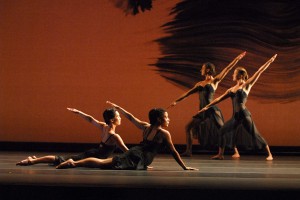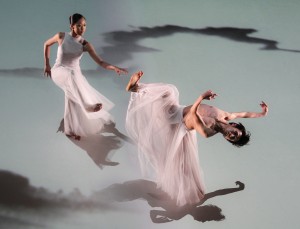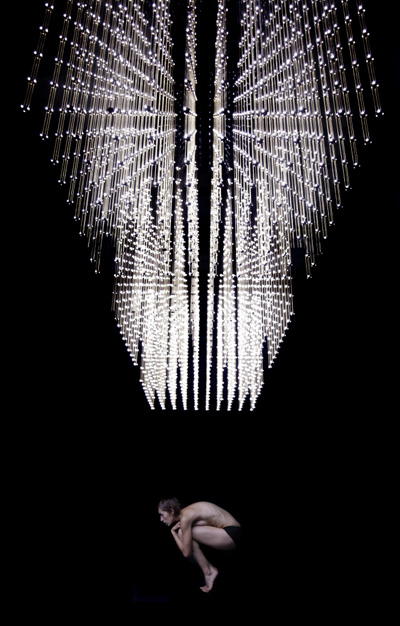What do Street Dance and Ballet have in common?

Photo: Compagnie Käfig performs Correria Agwa. They perform in Ann Arbor on February 14-15, 2014. Photo by Michel Cavalca.
Stand a ballerina and a break-dancer side by side and the differences are obvious – pointe shoes versus high tops. One might plié while the other may isolate an arm like a robot. Ask someone to describe the difference between performance dance (also known as concert dance) and street dance, and you’d probably receive a confident response: The first kind of dancer performs and the other dances informally, for passers-by and friends. But the distinction between these two genres may not be so clear, even for the dancers themselves.
Perhaps the terms may be to blame for this confusion. If we take them strictly at face value, we’d expect performance dancers to be performing (presumably on a stage of some kind) and street dancers to be dancing on a street somewhere. But while most ballerinas aren’t pirouette-ing in alleyways, there is a large concert-dance component to street dance. Even if street dancers hone their craft in a club, in a dance hall, or on the street somewhere, they still perform for an audience.
Compagnie Käfig, for example, is a dynamic France-based company that incorporates athletic samba, hip-hop, martial arts, capoeira dance, and even acrobatics into their style. Director and choreographer Mourad Merzouki and the dancers have been highly influenced by many styles that evolved “on the streets,” but they’ve incorporated them into choreography that is performed for an audience in a performance venue setting. Their moves, while likely pre-staged and pre-choreographed, have an air of improvisation and innovation. These moves, while perfected in the studio, may have been created through informal social interactions or collaboration in the regions where the styles originated. Compagnie Käfig dancers seem to combine characteristics of both street and performance dance.
Street dance, then, can better be defined as a reference to dance styles rather than as a description of where the dancing takes place. These styles, like b-boying, break-dancing, and even the Charleston, while taught in studios and performed on stages, evolved outside of the classroom – in nightclubs, at raves, at block parties, on the school yard, and yes, you guessed it – on the street. People who practiced these dances did not initially call themselves “street dancers,” but instead Bboys, lockers, breakers, or funkstylers. The styles were improvisational, and encouraged interaction with audience members and between the dancers themselves. The term “street dance” came along later when these dances were popularized in the 1980s.
Today, the terms “street dance” and “hip-hop dance” are often used to refer to a studio-based version of the styles, which, like the original street dances, are less defined than their performance-based counterparts. They are sometimes improvisational, but can also include choreographed steps.
Concert dance, on the other hand, is a style whose origins are a bit clearer. Ballet (likely the oldest of concert dances) emerged in the Italian Renaissance courts in the 15th century and evolved in its style as it spread to France and Russia. Today, its steps are entirely in French. Ballet is considered by most as the base of all concert dance styles (like jazz, modern, or contemporary), since it provides the foundational techniques used in many different genres. In fact, it is rare to find a professional dancer who hasn’t been trained in one of ballet’s styles. It’s not surprising that ballet originated as and remains a style of dance that is performed formally for a larger audience – pointe shoes demand special flooring, and partnering between male and female dancers requires pre-planned choreography rather than improvisation. The mimes and steps of classical ballet seem to have been created for the purpose of story-telling, and the tradition has remained alive.
When I think of the distinction between these two genres, I can’t help but envision Julia Stiles as she transforms from leotard-clad ballerina to hip-hop dancer in Save the Last Dance. Iconic dance movies like this one – which are for many people the only window into the dance world – may help us visualize the differences between performance and street dance, no matter how stereotypical they may be.
Movies like Step Up, Stomp the Yard, and Honey, the plots of which focus primarily on street dance, are wildly popular with a mainstream audience (as evidenced by their many sequels). Performance dance, while less popular, has surprisingly been the subject of a few mainstream titles like Black Swan and Center Stage, two movies that, while very different, hold a special place in my heart. These films tell the stories of the rigorous world of professional ballet, but even they aren’t devoid of a street dance influence – both films include that popular dancing-at-the-bar-as-relief motif.
What these films hint at is common in contemporary dance. Companies like Compagnie Käfig cross-over and cross-pollinate from various influences regularly. Is it possible that we all have something to gain from Channing Tatum in Step Up?
Interested in learning more? Check out our UMS Adventure Club: Dance, a game designed to reward your inquisitive instincts with the chance to win a special backstage meet and greet with a UMS artist.
11/12 Dance Series
The UMS Dance Series includes four events in Ann Arbor’s Power Center. The series begins with the Mark Morris Dance group performing two nights of new repertory. Two companies make their UMS debuts: Taiwan’s Cloud Gate Dance Theatre with Water Stains on the Wall and Random Dance, a company started by Wayne McGregor, whose groundbreaking collaborations across dance, film, music, visual art, and science are evident in the company’s presentation of FAR. Finally, Ballet Preljocaj’s production of Snow White, set to music by Gustav Mahler and featuring costumes by Jean Paul Gaultier, closes the dance season.
Subscription packages go on sale to the general public on Monday, May 9, and will be available through Friday, September 17. Current subscribers will receive renewal packets in early May and may renew their series upon receipt of the packet. Tickets to individual events will go on sale to the general public on Monday, August 22 (via www.ums.org) and Wednesday, August 24 (in person and by phone). Not sure if you’re on our mailing list? Click here to update your mailing address to be sure you’ll receive a brochure.
Mark Morris Dance Group
Friday & Saturday, September 23 & 24, 8 pm
Power Center
Mark Morris has changed the way that audiences see modern dance, with unique artistry that reflects a profound and sophisticated love of music. His company of exuberant dancers lives up to its reputation of wit, grace, and a refined musicality that is further reinforced by Morris’s use of live musicians in every performance. These two performances feature new Morris repertoire.

Program
Excursions (Barber’s Excursions for Piano, Op. 20)
Festival Dance (Hummel Piano Quartet)
Socrates (Erik Satie’s Socrates for tenor and piano)
Water Stains on the Wall
Cloud Gate Dance Theatre
Lin Hwai-min, artistic director
Friday, October 21, 8pm
Saturday, October 22, 8pm
Power Center
Trained in tai chi, meditation, Chinese opera movement, modern dance, and ballet, Cloud Gate Dance Theatre performs a rich repertoire with roots in Asian myths, folklore, and aesthetics, all infused with a contemporary perspective. For this long-awaited UMS debut, Cloud Gate presents Hwai-min’s newest work, Water Stains on the Wall. “Water stains on the wall” is a popular metaphor that represents the highest state in the aesthetics of Chinese calligraphy. Hwai-min and dancers take off from this metaphor and create and abstract work of beauty and magic that stands sublimely on its own.
FAR
Random Dance
Wayne McGregor, artistic director
Friday, February 17, 8 pm
Power Center
Random Dance was founded in 1992 and became the instrument upon which Wayne McGregor evolved his drastically fast and articulate choreographic style. The company became a byword for its radical approach to new technology, incorporating animation, digital film, 3D architecture, electronic sound, and virtual dancers into the live choreography. In FAR, cutting edge design is fused with choreography made from a radical cognitive research process. FAR “talks about the Enlightenment’s fascination with the working of the mind and the dissection of the body…draw[ing] to a close with…the utmost tenderness and finality.” (The Times, London)
Snow White
Ballet Preljocaj
Angelin Preljocaj, artistic director
Thursday, April 19, 7:30 pm
Friday, April 20, 8 pm
Saturday, April 21, 8 pm
Power Center
After more than a decade since its UMS debut, Ballet Preljocaj (pronounced prezh-oh-kahzh) returns with its production of Snow White. Angelin Preljocaj has created a work for all 26 dancers of his company, setting the Grimm brothers’ version of the fairytale to the most beautiful scores of Gustav Mahler’s symphonies for this romantic contemporary ballet. With costumes designed by Jean Paul Gaultier, this production of Snow White is sure to shake up those who have grown up with only the Disney version at their disposal.
Return to the complete chronological list.
UMS Arts Roundup: November 19
Many members of the UMS staff keep a watchful eye on local and national media for news about artists on our season, pressing arts issues, and more. Each week, we pull together a list of interesting stories and share them with you. Welcome to UMS’s Arts Round-up, a weekly collection of arts news, including national issues, artist updates, local shout-outs, and a link or two just for fun. If you come across something interesting in your own reading, please feel free to share!
Arts Issues
- What’s next on the list to download to your ipod? Ballet!
- The use of captions during plays give theaters access to new audiences, including the hearing impaired.
- 2011 Edinburgh International Festival to focus on Asian culture and influence.
Artist Updates
- World famous composer Philip Glass writes a new opera, to premiere in 2013.
- Alongside 14 others, Yo-Yo Ma is awarded the Presidential Medal of Freedom—the country’s highest civilian honor—from President Obama.
UMS News
- Annarbor.com performance review of Stew & the Negro Problem at the old Leopold’s pub. Additional performances on Friday and Saturday!
Local Shout-Outs
- Intriguing exhibit opens at DIA, looking at artist fakes and the detective work used to verify artworks.
- Students host EMU music festival featuring local bands.
Just For Fun
- Check out this circus-like version of “Swan Lake” that has lately been making the rounds on youtube. Amazing or horrifying? You decide!
UMS’s Arts Roundup: August 27
Many members of the UMS staff keep a watchful eye on local and national media for news about artists on our season, pressing arts issues, and more. We thought we’d pull together a list of interesting stories each week and share them with you. Welcome to UMS’s Arts Round-up, a weekly collection of arts news, including national issues, artist updates, local shout-outs, and a link or two just for fun. If you come across something interesting in your own reading, please feel free to share!
Arts Issues
- Pianomania puts the wishes of the world’s greatest pianists in the spotlight from the perspective of their Steinway technician
- The Wall Street Journal takes a look at how a new generation of leadership is changing the role of art museums
Artist Updates
- Just who is Grupo Corpo? Here’s a primer from UK’s The Guardian
- And now that you know them, check out a review of Grupo Corpo’s latest work, Parabelo
- In tough times, the Seattle Symphony opts for a “new” approach, commissioning 18 new works for the 10/11 season
- The New York Times reviews a new biography about Ballets Russes master Serge Diaghilev
Local Shout-Outs
- Introducing a new ballet troupe in metro Detroit – crazy talk or toast of the town?





